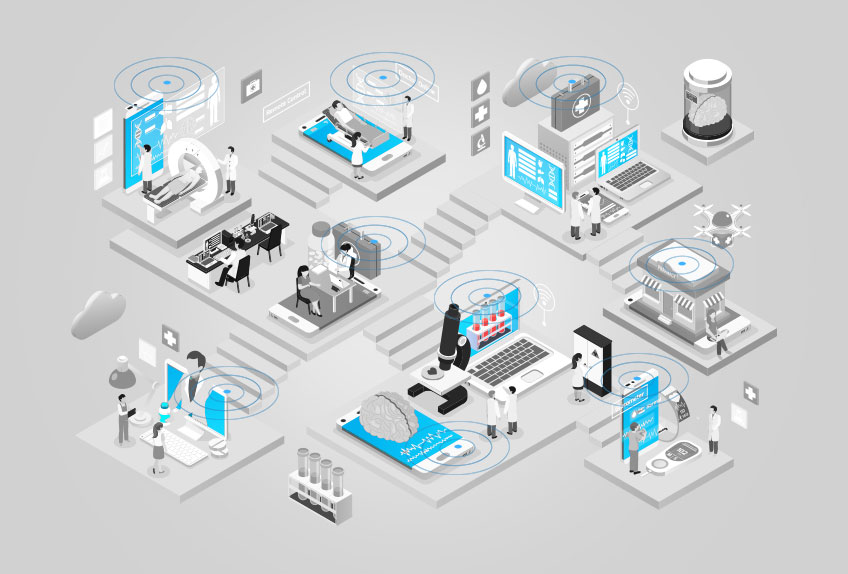Wireless connectivity has radically transformed healthcare facilities over the past few decades. Pagers have given way to smartphones, paper charts to laptop computers, long check-in forms to digital ones – these changes have all happened over the last 20 years. It is not a stretch of the imagination to say connectivity has been a cornerstone in bringing about a digital health revolution.
Similarly, the future of healthcare also depends on seamless connectivity. Technology improves the patient experience and boosts HCAHPS (Hospital Consumer Assessment of Providers and Systems) scores by providing a better comprehensive and personalized support and comfort system. And as the wireless industry continues to evolve with 5G and in-building cellular, a seamless network is essential for the proper and smooth functioning of healthcare facilities.
In-Building Cellular Network Issues in Hospital
A modern hospital has many different devices, not including visitor devices. In addition to this, hospital staff devices have to support a wide variety of carriers and have connectivity across multiple frequency bands. When it comes to construction, hospitals are generally fully covered with reflective glass, sealed windows, and have thick walls that can prevent signals from penetrating into the facility. As a result of all these factors, it’s pretty common to walk into hospitals to find virtually no signal bars on your cell phone devices. This can have huge consequences in the workflow of a hospital while also hampering the ability of patients to keep in touch with their loved ones.
In-Building Connectivity and Healthcare
Wireless monitoring devices allow doctors and nurses to remotely monitor the wards and rooms reducing the risk of any emergencies. These devices are also made to be incredibly secure and focus on patient safety, data accuracy, and mobility. This has a great impact with nurses reporting 61% fewer medication errors, a 58% increase in time spent with patients, a 52% reduction in specimen collection errors, and a 28% reduction in patient care errors. There has also been a major reduction in alarms per nurse per shift.
Additionally, reports suggest that 90% of healthcare facilities are implementing a mobile device initiative. Over the next four years, the in-building communication nodes are projected to increase by 232% with mobile devices being used in nurses’ stations, administrative offices, and patient rooms. With so many interlinked devices, a reliable wireless connection is critical for patient health and workflows within facilities, and a seamless network may be the difference between life and death.
Healthcare Connectivity and IoT
In healthcare, the IoHT or IoMT, Internet of Medical Things, refers to various devices that doctors rely on to monitor, diagnose and treat patients. With more IoMTs making their way into hospitals, the need for seamless in-building connectivity becomes more essential. As these devices increase, hospitals will require a massive increase in the amount of bandwidth. The increased traffic may cause networks to suffer or even lead to failed connections on some devices. This has the potential of significantly reducing the impact of IoT in healthcare, which is why it’s essential for hospitals to upgrade their in-building connectivity.
Smart Hospitals with Seamless Connectivity
The future of healthcare will see smart hospitals designed to be fully connected across the many devices in it. Things like smart TVs, patient engagement systems, app-based lighting and temperature controls, remote patient monitoring software are all going to be a part of this ecosystem. Voice control will also be a huge part of hospital facilities going forward to reduce the load on patients and carers.
Facial recognition technology can allow for seamless staff check-in and better patient tracking when integrated with the cameras already in the building. There will also be integrated command centers that provide a connectivity-enabled dashboard to better manage patient flows, optimize staff schedules and make better decisions regarding AI and predictive care. None of this will be possible without a network solution.
In-building DAS Solutions for Healthcare
As more medical facilities adopt telemedicine and telehealth, more IoMT devices and grow in physical size, the amount of bandwidth required is only going to grow. In most cases, this cannot be supplemented by WiFi or regular DAS infrastructure. They require a more intensive DAS-enabled system where sensitive equipment and machinery are kept isolated while other areas have seamless cellular coverage in the hospital. This is where Digital DAS comes in. Digital DAS gives hospitals more control over the capacity of the network while also facilitating multiple-input multiple-output technology.
Digital DAS today supports 4G LTE and can be upgraded to support 5G upon availability. This is why it’s fully feasible to deploy a digital DAS solution now as it makes it easy to transition to 5G. If you are a hospital network administrator, making this change now will be much easier and cost-effective when compared to a time where 5G is readily available. In case you would like to install a digital DAS solution for your hospital, then please get in touch with Kaytech Coverage. Our team of expert network engineers are fully capable of upgrading your in-building connectivity while ensuring there is no disruption to the workflow within your facility.


